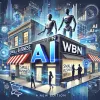
By George Moen | Publisher | May 17, 2025
Microsoft just laid off 6,000 employees as it doubles down on AI. Here's what happened, who it affected, and what it means for the future of work and small businesses.
A New Era, A Ruthless Shift
In a dramatic move emblematic of today’s AI-driven corporate realignment, Microsoft laid off approximately 6,000 employees on May 13, 2025—roughly 3% of its global workforce. It’s the tech giant’s most considerable workforce reduction since early 2023.
The cuts span key business units—LinkedIn, Azure, Xbox, and AI. Gabriela de Queiroz, Microsoft’s Director of AI for Startups, was among those let go. The layoffs affect engineers, middle management, and technical program managers across North America and abroad.
AI: Both the Architect and Executioner
Microsoft is investing an estimated $80 billion in AI infrastructure this fiscal year. In addition to that investment, it is pushing to flatten internal management and boost efficiency with generative AI.
CEO Satya Nadella has openly stated that AI now contributes up to 30% of code written across specific projects, automating tasks that previously required large dev teams. The company is shifting manager-to-engineer ratios in some departments from 5.5:1 to 10:1, signaling a structural upheaval powered by intelligent systems.
The Fallout: Real People, Real Pain
Affected employees took to LinkedIn in waves, some sharing heartbreak, and others offering financial and emotional resilience tips. Former Microsoft employee Sital Ruparelia encouraged laid-off professionals to prioritize fitness, networking, and mental clarity in their next chapter.
This is not just a corporate maneuver; it's an emotional event, especially for those now caught between industries reshaped by automation and unclear pathways to reskill.
Why It Matters – The AI Impact on Small Business
The AI Impact Report™ exists to spotlight moments like this. Microsoft’s layoffs aren’t just a tech story but a blueprint.
As enterprise giants like Microsoft automate more roles, small businesses must adapt faster than ever to stay relevant. Whether it’s AI writing your code, handling customer service, or managing internal operations, the shift is permanent.
For solo entrepreneurs and Main Street founders, the lesson is clear:
Understand AI. Use it. Or risk being left behind.
📊 Addendum – What 6,000 Jobs Cost
Estimates suggest the average Microsoft tech employee earns around $200,000/year in total compensation (base, stock, benefits, and overhead).
- 6,000 × $200,000 = $1.2 billion/year
This means Microsoft’s workforce reduction could reduce annual operating expenses by $1.2 billion, freeing up capital to accelerate its aggressive $80B AI reinvestment strategy.
George Moen – Publisher, WBN AI Edition
📧 Email: gmoen@wbnn.news
TAGS: #AI Impact Report #Microsoft #AI Layoffs #Small Business #AI and Work #Future Of Jobs #WBN News #c #Digital Shift #Automation Trend
Fact Check:
✅ Layoffs: 6,000 Employees (~3% of Workforce)
Confirmed. Microsoft announced plans to lay off approximately 6,000 employees, representing about 3% of its global workforce.
Source: Financial Times
✅ AI Investment: $80 Billion in FY2025
Confirmed. In fiscal year 2025, Microsoft plans to invest around $80 billion in AI-enabled data centers and infrastructure.
Source: Reuters
✅ AI Writing Up to 30% of Code
Confirmed. CEO Satya Nadella has publicly stated that AI contributes between 20% and 30% of the code in specific Microsoft projects.
Source: Tom’s Hardware
✅ Manager-to-Engineer Ratio Shift: 5.5:1 to 10:1
Confirmed. Microsoft is restructuring departments like Security to raise the engineer-to-manager ratio from 5.5:1 to 10:1.
Source: HR Grapevine
✅ Gabriela de Queiroz Laid Off
Confirmed. Gabriela de Queiroz, formerly Director of AI for Startups at Microsoft, confirmed her layoff in a public social media post.
Source: LinkedIn
✅ Estimated Annual Cost of 6,000 Employees: $1.2 Billion
Plausible. Using an estimated $200,000 in total annual compensation per employee (including benefits and overhead), 6,000 employees would cost around $1.2 billion annually.
Source: WBN Analysis based on industry averages




